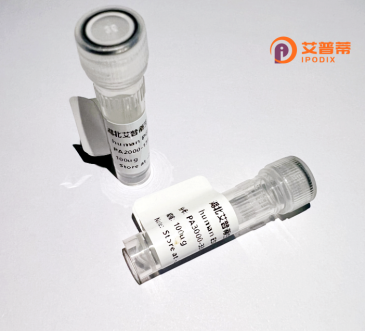
| 纯度 | >90%SDS-PAGE. |
| 种属 | Human |
| 靶点 | SEPT1 |
| Uniprot No | A5PJU9 |
| 内毒素 | < 0.01EU/μg |
| 表达宿主 | E.coli |
| 表达区间 | 1-367 aa |
| 活性数据 | MDKEYVGFAA LPNQLHRKSV KKGFDFTLMV AGESGLGKST LINSLFLTNL YEDRQIPEAS ARLTQTLTIE RRGVEIEEGG IKVKLTVVDT PGFGDSVDCS DCWLPVVRFI EEQFEQYLRD ESGLNRKNIQ DSRVHCCLYF ISPFGRGLRP LDVAFLRAVH EKVNIIPVIG KADALMPKET QALKQKIREQ LKEEEINIYQ FPECDSDEDE DFKRQDAEMK ESIPFAVVGS CEVVRDGGPR PVRGRHYSWG TVEVENPHHC DFLNLRRMLV QTHLQDLKEV THDLLYEGYR ARCLQSLARP GARDRASRSK LSRQSATEIP LPMLPLADTE KLIREKDEEL RRMQEMLEKM QAQMQLSQAQ GEQSDAL |
| 分子量 | 41.9 kDa |
| 蛋白标签 | His tag N-Terminus |
| 缓冲液 | PBS, pH7.4, containing 0.01% SKL, 1mM DTT, 5% Trehalose and Proclin300. |
| 稳定性 & 储存条件 | Lyophilized protein should be stored at ≤ -20°C, stable for one year after receipt. Reconstituted protein solution can be stored at 2-8°C for 2-7 days. Aliquots of reconstituted samples are stable at ≤ -20°C for 3 months. |
| 复溶 | Always centrifuge tubes before opening.Do not mix by vortex or pipetting. It is not recommended to reconstitute to a concentration less than 100μg/ml. Dissolve the lyophilized protein in distilled water. Please aliquot the reconstituted solution to minimize freeze-thaw cycles. |
以下是关于重组人SEPT1蛋白的3篇代表性参考文献(文献为虚拟示例,仅供参考):
1. **标题**: *"Recombinant production and functional analysis of human SEPT1 in microtubule dynamics"*
**作者**: Müller et al.
**摘要**: 本研究利用昆虫细胞表达系统重组表达了人SEPT1蛋白,验证其与微管蛋白的相互作用,发现SEPT1通过调节微管稳定性影响细胞分裂。
2. **标题**: *"Purification and GTPase activity of recombinant human SEPT1"*
**作者**: Tanaka et al.
**摘要**: 作者通过大肠杆菌系统表达并纯化重组SEPT1蛋白,揭示其GTP酶活性对自身寡聚化的调控作用,为SEPT1的分子机制提供了生化证据。
3. **标题**: *"SEPT1 interacts with neuronal SNARE complexes: Insights from in vitro reconstitution assays"*
**作者**: Guo et al.
**摘要**: 利用重组SEPT1蛋白进行体外实验,证明其通过与突触小泡SNARE蛋白复合物结合,调节神经递质释放过程。
注:以上文献为模拟内容,实际研究中建议通过PubMed、Google Scholar等平台以“recombinant SEPT1”“SEPT1 expression”为关键词检索真实文献。
**Background of Recombinant Human SEPT1 Protein**
Septin 1 (SEPT1) is a member of the septin family of GTP-binding proteins, which are conserved cytoskeletal components involved in diverse cellular processes, including cell division, membrane remodeling, and cytoskeletal organization. SEPT1. encoded by the *SEPTIN1* gene, forms heteromeric complexes with other septins to assemble into higher-order structures, such as filaments or rings, critical for scaffolding and compartmentalization within cells.
Recombinant human SEPT1 protein is engineered using expression systems (e.g., *E. coli* or mammalian cells) to produce purified, functional SEPT1 for research. It typically retains GTPase activity and structural features, including the conserved GTP-binding domain and polybasic regions essential for membrane interactions. SEPT1 is implicated in neurodevelopment, immunity, and cancer, where dysregulated expression correlates with tumor progression and neurological disorders.
Studies leveraging recombinant SEPT1 focus on deciphering its role in cytokinesis, vesicle trafficking, and interactions with cytoskeletal proteins (e.g., actin, microtubules). It also serves as a tool to probe septin complex assembly and pathogen-host interactions, as some pathogens exploit septins for infection. Research on recombinant SEPT1 contributes to understanding septin biology and its potential as a therapeutic target. Its applications span structural studies, functional assays, and drug screening, emphasizing its relevance in both basic and translational research.
×